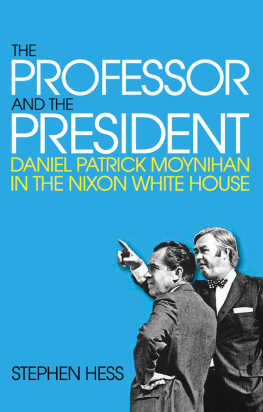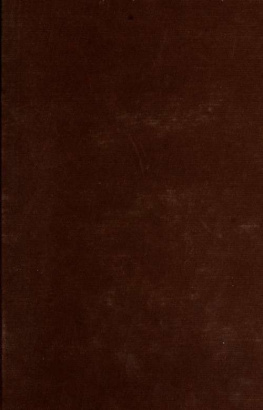When Stephen Hess joined the Nixon White House staff in January 1969 his official title was Deputy Assistant to the President for Urban Affairs, but his role would turn out to be much more complex.
As Hess writes in his opening to The Professor and the President, I am the only personperhaps in the worldwho was a friend of both Richard Nixon and Daniel Patrick Moynihan before they knew each other.
Nixon needed a prominent Democrat in his cabinet. Moynihan needed reentry to Washington's power center. From its origins in a brief political codependence, the relationship blossomed.
Nixon grew fascinated by Moynihan, who advised the president on what books to read, to whom he should award the Presidential Medal of Freedom, and how not to redecorate the Oval Office.
Moynihan earned Nixon's support in battles with Arthur Burns, the conservative economist who served as counselor to the president. Nixon went on to propose the Family Assistance Plan, one of the most progressive pieces of welfare legislation since the New Deal.
Told as if from his office in the West Wing basement across from the Situation Room, Hess peppers the story with anecdotes: chance encounters with visiting celebrities such as Kirk Douglas, conversations with Henry Kissinger conducted in a White House men's room, and the Duke Ellington soiree that became a Blue Note record. All add up to a vivid portrait of one of the most overlooked relationships in twentieth century American politics.
Three of Daniel Patrick Moynihan's iconic bow ties now hang in Stephen Hess's home.
STEPHEN HESS is a Brookings senior fellow emeritus who served on the White House staffs of Presidents Eisenhower and Nixon and advised Presidents Ford and Carter. He was Nixon's biographer and Moynihan's chief-of-staff. His many books include the critically acclaimed Organizing the Presidency (Brookings, 2002, 1988, 1976).
Cover photo adapted from and courtesy of Creative Commons
Jacket Design: Sese-Paul Design
Copyright 2015
THE BROOKINGS INSTITUTION
1775 Massachusetts Avenue, N.W., Washington, D.C. 20036
www.brookings.edu
All rights reserved. No part of this publication may be reproduced or transmitted in any form or by any means without permission in writing from the Brookings Institution Press.
The Brookings Institution is a private nonprofit organization devoted to research, education, and publication on important issues of domestic and foreign policy. Its principal purpose is to bring the highest quality independent research and analysis to bear on current and emerging policy problems. Interpretations or conclusions in Brookings publications should be understood to be solely those of the authors.
Library of Congress Cataloging-in-Publication data is available
ISBN 978-0-8157-2615-9 (cloth : alk. paper)
ISBN 978-0-8157-2616-6 (e-book)
9 8 7 6 5 4 3 2 1
Printed on acid-free paper
Typeset in Sabon and ITC Avant Garde
Composition by Cynthia Stock
Silver Spring, Maryland
THE CAST
Richard M. Nixon, President of the United States
Spiro T. Agnew, Vice President of the United States
The Cabinet
William Rogers, Secretary of State
David Kennedy, Secretary of the Treasury
Melvin Laird, Secretary of Defense
John Mitchell, Attorney General
Winton Blount, Postmaster General
Walter Hickel, Secretary of the Interior
Clifford Hardin, Secretary of Agriculture
Maurice Stans, Secretary of Commerce
George Shultz, Secretary of Labor
Robert Finch, Secretary of Health, Education, and Welfare
George Romney, Secretary of Housing and Urban Development
John Volpe, Secretary of Transportation
The White House
Arthur Burns, Counselor to the President (cabinet rank)
H. R. Haldeman, Assistant to the President (chief of staff)
John Ehrlichman, Counsel to the President
Henry Kissinger, Assistant to the President for National Security Affairs
Daniel Patrick Moynihan, Assistant to the President for Urban Affairs
Bryce Harlow, Assistant to the President (congressional relations)
Peter Flanigan, Assistant to the President (personnel, business community)
Leonard Garment, Consultant to the President
Charles (Bud) Wilkinson, Consultant to the President (voluntary organizations)
Herbert Klein, Director of Communications for Executive Branch
Stephen Hess, Deputy Assistant to the President for Urban Affairs
Ronald Ziegler, Special Assistant to the President (press secretary)
Martin Anderson, Special Assistant to the President (aide to Arthur Burns)
Dwight Chapin, Special Assistant to the President (scheduling, appointments)
Harry Flemming, Special Assistant to the President (personnel)
Pat Buchanan, Special Assistant to the President (speeches)
Ray Price, Special Assistant to the President (speeches)
William Safire, Special Assistant to the President (speeches)
Lee Huebner, Staff Assistant to the President (speeches)
Other Administration Officials
Donald Rumsfeld, Director, Office of Economic Opportunity (cabinet rank)
Paul McCracken, Chairman, Council of Economic Advisers
Robert Mayo, Director, Bureau of the Budget
Richard Nathan, Assistant Director, Bureau of the Budget (human resources)
Robert Ellsworth, U.S. Ambassador to NATO
PREFACE: BETWEEN NIXON AND MOYNIHAN
I am the only personperhaps in the worldwho was a friend of both Richard Nixon and Daniel Patrick Moynihan before they knew each other.
The Professor and the President is the story of the consequences of their paths crossing in 1969, when a conservative president made a liberal professor his urban affairs adviser in the White House.
For Moynihan, this was a trajectory change that would lead ultimately to his becoming U.S. ambassador to India, appointed by Nixon; U.S. representative to the United Nations, appointed by President Gerald Ford, Nixon's successor; and through his celebrity at the UN to the U.S. Senate, where he was elected four times from New York.
For Nixon, it imbued his domestic policy with a progressive cast that he had neither promised nor imagined.
I FIRST MET Nixon just after he lost the presidency to John F. Kennedy in 1960 and returned to California. I had been a speechwriter for President Eisenhower from 1958 to 1961, when Nixon was vice president. Nixon was not a presence in the White House, because he didn't have an office like subsequent vice presidents. In fact, Eisenhower considered the vice presidency to be constitutionally part of the legislative branch.
When it was over, Eisenhower got in his old car and was driven the 80 miles home to Gettysburg, Pennsylvania. Ex-presidents then did not get the staff, offices, and other perks they now require. The Republican National Committee determined that to keep Ike alive politically, someone would have to answer his mail. The job that I accepted was to be piecework, paid so many cents per letter. We failed to anticipate the deluge: it seemed like every student in America wanted Ike's opinion on what was that year's national debate topic, others wanted something for their charity auctions or his autograph, and some just wanted to say hello. (These letters provided the windfall that allowed me to become an independent writer.)










